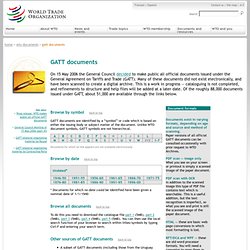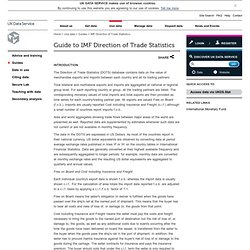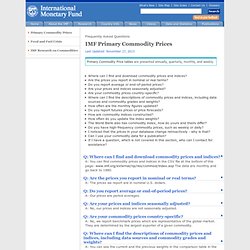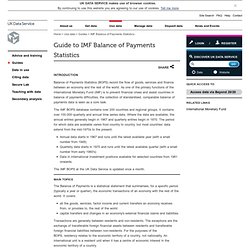

SICE (OAS)Trade and Investment Flows. UNCTAD. UNCTSTAT. Information Economy Report (Series) World Investment Reports. World Trade Organization. WTO trade monitoring database. GATT documents. Browse by symbol back to top GATT documents are identified by a “symbol” or code which is based on either the issuing body or subject matter of the document.

Unlike WTO document symbols, GATT symbols are not hierarchical. Documents for which no link appears are not available electronically Browse by date back to top * Documents for which no date could be identified have been given a nominal date of 1/1/1940 Browse all documents back to top To do this you need to download the catalogue file part 1 (5MB), part 2 (5MB), part 3 (5MB), part 4 (5MB), part 5 (5MB). Other sources of GATT documents back to top A subset of GATT documents (including those from the Uruguay Round — about 4000 documents) is available in Documents Online.
Stanford University Library scanned much of the GATT collection and makes the documents available through their website with a search engine. Documents Online. Statistics database. World Trade yearbook. World Bank commodity price data. UNIDO industrial demand supply databases. International Monetary Fund Home Page. IMF Direction of Trade Statistics dataset guide.
The Direction of Trade Statistics (DOTS) database contains data on the value of merchandise exports and imports between each country and all its trading partners.

Total bilateral and multilateral exports and imports are aggregated at national or regional group level. For each reporting country or group, all the trading partners are listed. The corresponding monetary values of total imports and total exports are then provided as time series for each country/trading partner pair. All exports are valued Free on Board (f.o.b.). Imports are usually reported Cost including Insurance and Freight (c.i.f.) although a small number of countries report imports f.o.b.. Area and world aggregates showing trade flows between major areas of the world are presented as well. The data in the DOTS are expressed in US Dollars.
Free on Board and Cost including Insurance and Freight Each individual country's export data is shown f.o.b. whereas the import data is usually shown c.i.f.. Main topics Access IMF data. Primary Commodity Prices: Frequenly Asked Questions (FAQs) Frequently Asked Questions Last Updated: November 27, 2013 Q: Where can I find and download commodity prices and indices?

A: You can find commodity prices and indices in the CSV file at the bottom of this page: www.imf.org/external/np/res/commod/index.asp The data are monthly and go back to 1980. Q: Are the prices you report in nominal or real terms? A: The prices we report are in nominal U.S. dollars. Q: Do you report average or end-of-period prices? IMF Balance of Payments Statistics (BOPS) dataset guide. Balance of Payments Statistics (BOPS) record the flow of goods, services and finance between an economy and the rest of the world.

As one of the primary functions of the International Monetary Fund (IMF) is to prevent financial crises and assist countries in balance of payments difficulties, the collection of standardised, comparable balance of payments data is seen as a core task. The IMF BOPS database contains over 200 countries and regional groups. It contains over 100,000 quarterly and annual time series data. Where the data are available, the annual entries generally begin in 1967 and quarterly entries begin in 1970.
The period for which data are available varies from country to country, but most countries’ data extend from the mid-1970s to the present. The IMF BOPS at the UK Data Service is updated once a month. Main topics Transactions are generally between residents and non-residents.